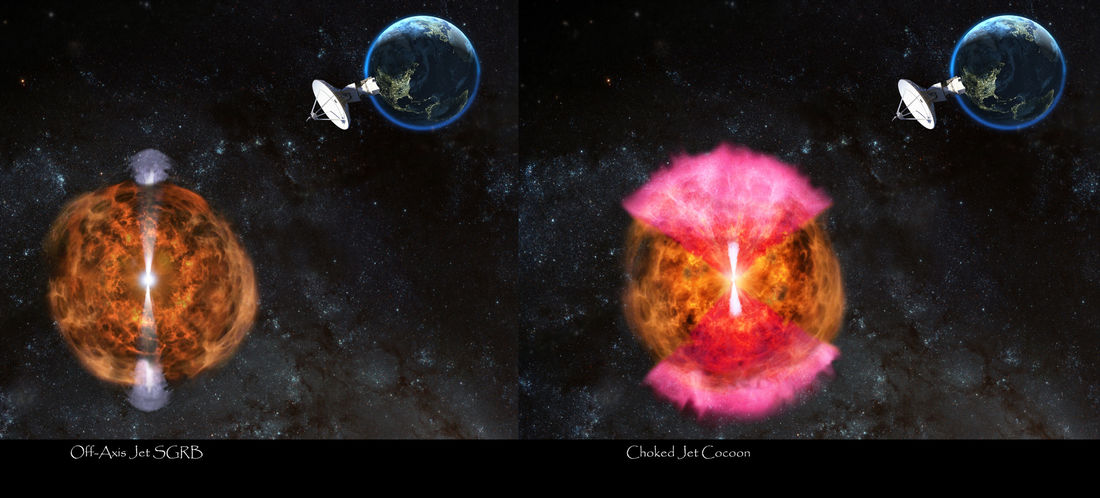|
A Swinburne astronomer is part of an international discovery effort bringing scientists one step closer to understanding the physics of binary neutron star mergers and the universe at large. The discovery, made by an international team of astronomers, suggests that a narrow and super-fast 'jet' of material blasted out during the cataclysmic neutron star merger, slammed into the environment surrounding the merging neutron stars and inflated a bubble-like cocoon. The findings, published in Nature, contradict a popular theory describing the aftermath of the recently observed neutron star merger — namely, that the beam-like jet thought to be associated with highly energetic phenomena called gamma-ray bursts had been seen directly, immediately after the merger. “The burst of gamma-rays from this merger didn't come directly from a tightly focused, high-speed jet that just grazed our line of sight; instead, we attribute them to a more slowly moving outflow of material that had absorbed some of the jet’s energy,” says Swinburne astronomer Dr Adam Deller, ARC Future Fellow at the Centre for Astrophysics and Supercomputing and Associate Investigator at the ARC Centre of Excellence for Gravitational Wave Discovery. “We confirmed this by studying the radio emission produced by this outflowing material weeks and months after the merger.” Dr Deller believes this finding will impact astronomy in two important ways. “The 'canonical' model of what happens when neutron stars merge will be revised and improved,” he says. “And when LIGO detects more binary neutron star mergers in the future, we now expect to see an 'afterglow' counterpart more frequently than previously expected, which will help us pin down their locations and is good news for learning more about the extreme physics of these merger events.” Australia and the world looking to the skies The findings were made possible by the cooperative efforts of a team of astronomers and facilities world-wide, and Dr Deller stresses the importance of having radio telescopes in Australia and the world monitoring these events. "As we've kept our radio telescopes trained on the site of this event, we've continued to learn more and more about the nature of the explosion that accompanied the neutron star merger,” he says. "Having a suite of radio telescopes world-wide, including in Australia, has underpinned this monitoring effort. By observing at a range of times and radio frequencies, we've learnt much more about the explosion than any one facility could have provided alone." Dr Tara Murphy, an ARC fellow at University of Sydney who led observations with the Australia Telescope Compact Array, says that detecting and monitoring radio waves is critical to understand what happens when two neutron stars merge. “We now know that what we’re observing is not what we expected - we haven’t seen anything quite like it before.” “Australian facilities have played a vital role in monitoring radio waves from the merger. We’re able to detect this high energy event, 130 million light years away, tracking it as the explosion evolves with time.” Looking to the future The research team say that future observations with international telescopes LIGO, Virgo, and others will help further clarify the origins and mechanisms of these extreme events. The observatories should be able to detect additional neutron-star mergers—and perhaps eventually, mergers of neutron stars and black holes. The findings were made with the Karl G. Janksy Very Large Array in New Mexico, the CSIRO Australia Telescope Compact Array, and the Giant Meter-wave Radio Telescope in India. The lead author is Kunal Mooley, formerly of the University of Oxford and now a Jansky Fellow at Caltech. To view the complete findings, see: A mildly relativistic wide-angle outflow in the neutron star merger GW170817 Image credit: NRAO/AUI/NSF: D. Berry.
The image shows a radio telescope (upper right) observing GW170817 (lower left). The jet within GW170817 (narrow bright beam emanating from GW170817) has dissipated its energy into the dynamical ejecta (shown in brown/yellow) and thus given rise to a wide-angle outflow (shown in red/pink) - a scenario called the choked-jet cocoon.
0 Comments
Leave a Reply. |
|
- Home
- About
-
Our People
- Chief Investigators
- Partner Investigators
- Associate Investigators
- Postdocs and Students >
- Professional & Outreach staff
- Governance Advisory Committee
- Scientific Advisory Committee
- Executive Committee
- Equity & Diversity Committee
- Early Career Researcher Committee
- Professional Development Committee
- Research Translation Committee
- OzGrav Alumni
- Research Themes
- Education and Outreach
- Events
- News/Media
- Contact Us
- Home
- About
-
Our People
- Chief Investigators
- Partner Investigators
- Associate Investigators
- Postdocs and Students >
- Professional & Outreach staff
- Governance Advisory Committee
- Scientific Advisory Committee
- Executive Committee
- Equity & Diversity Committee
- Early Career Researcher Committee
- Professional Development Committee
- Research Translation Committee
- OzGrav Alumni
- Research Themes
- Education and Outreach
- Events
- News/Media
- Contact Us


 RSS Feed
RSS Feed








